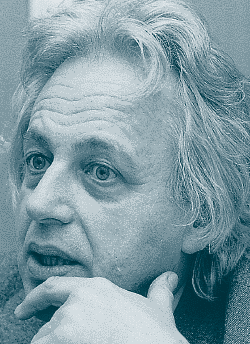|
|
György Ligeti
Gavin Thomas introduces the work of György Ligeti (1923–).
Overview
Ligeti’s creative outlook has been formed by his experiences
under two dictatorships – those of Hitler and Stalin.
A Jew born in Transylvania just as Hungary was losing that region to
Romania, he survived World War II in a labour camp (his brother and
father, less fortunate, both died in Auschwitz).
Following the war, he studied and taught at the Budapest Academy, but
fled after the crushing of the anti-Soviet uprising in 1956. Arriving in
Cologne he became an associate of Stockhausen at the WDR electronic music
studio, where he rapidly caught up on the musical developments from which
he had been cut off in Hungary.
In the 1960s he emerged as a leading member of the international avant-garde.
Since then he has lived mostly in Hamburg and Vienna, becoming an Austrian citizen in 1967.
As Ligeti has remarked of the traumatic experiences which have shaped his life and
artistic outlook, “I am permanently scarred; I will be
overcome by revenge fantasies to the end of my days.”
And yet, despite his work’s penchant for the surreal and the grotesque,
he is the most approachable, as well as one of the most fascinating and compelling,
of postwar composers.
A feeling of loss and nostalgia characterizes much of his output,
often evoked by the haunting modalities of East European folk music –
but pathos is balanced by absurdist humour, most notoriously in the
twenty-minute Poème symphonique for 100 metronomes,
a surreal jeu d’esprit which, composed shortly after Ligeti’s
arrival in the West, signalled his intention of finding an entirely personal
route out of the creative impasse of post-war music.
Ligeti’s highly individual creative trajectory –
as embodied by the tongue-in-cheek Poème – was developed in
his orchestral works of the 1960s such as Apparitions, Atmosphères and Lontano.
Rejecting the serial complexities favoured by contemporaries such as Stockhausen and Boulez,
these early works instead embarked on a back-to-basics re-examination
of music from the bottom up, stripping away all extraneous musical
matter in favour of a style based on pure texture, with
vast masses of sound in the process of slow creation and transformation.
At the same time, Ligeti’s maverick sense of humour expressed itself
in the quasi-theatrical Aventures and Nouvelles aventures,
a pair of exuberant vocal works setting nonsense phonetic texts, and
the imposing Requiem, Ligeti’s summatory
early work, which combines the sound-mass textures of the
orchestral pieces and the zany theatricals of Aventures to disturbing effect.
The cloudy sound-masses of these early works are typically created out
of microscopic tangles of intertwined instrumental lines – a kind
of musical spider’s web, described by the composer as “micro-polyphony”.
In Ligeti’s works of the later 1960s and early 1970s
the lines gradually become clearer, reintroducing a sense – albeit a rather
peculiar one – of melody, counterpoint and harmony, while rhythm
also resurfaces, often in the form of crazily superimposed pulses
or psychotically fast instrumental outbursts, like the deranged functioning of
some vast mechanical instrument.
In works such as the Chamber Concerto, Melodien and the Double Concerto for
flute and oboe Ligeti pushes this style to its limits, creating a compellingly
strange musical world, at once eerie and beautiful.
Ligeti’s major project of the 1970s, the opera Le Grand Macabre,
both summed up all his previous creative preoccupations and
sowed many of the seeds which were to germinate in subsequent works.
Following the opera (premiered in 1978) and a period of
serious illness, Ligeti’s style underwent a profound evolution, as first
demonstrated by the moving Trio for Violin, Horn and Piano of 1982,
a work in which a kind of tonality and traditional metre reappear
in his work for the first time in over two decades, but lopsided
or dislocated to comic or disturbing effect.
It was in subsequent works – most notably two prodigious concertos, for
piano and violin, and an ongoing sequence of études
for piano (currently numbering 17) – that Ligeti finally brought to fruition
the long work of musical recovery that had begun with Apparitions.
In all these works there are overt references to
traditional classical (and other) music, often
with a decidedly Eastern European flavour, but recontextualized in Ligeti’s
inimitably personal manner and often expressed in a
complex rhythmic style in which conflicting layers of tempos are
used to drive the music forward.
Article and review pages originally published in The Rough Guide
to Classical Music
|